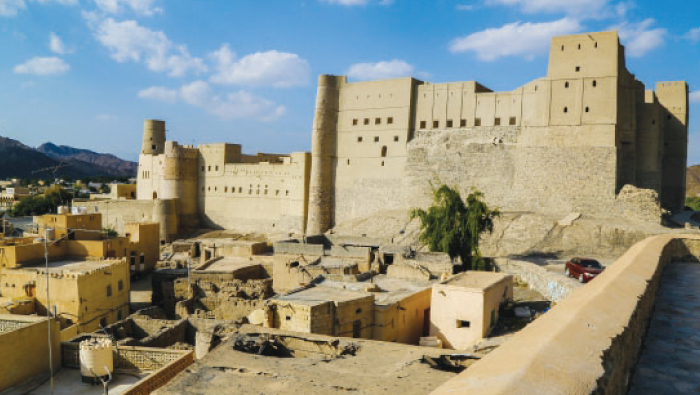
Known for its rich historical past and heritage, Oman has several monuments, forts and ruins that have been designated as World Heritage Sites by UNESCO. According to the NCSI, Oman has a total of 9,403 heritage sites, 1,029 of them being cultural Omani villages. In June 2018, the ruins of Qalhat near Sur were recognised as a World Heritage Site by UNESCO. The Ancient City of Qalhat, the aflaj irrigation systems of Oman, Archaeological Sites of Bat, Al Khutm and Al Ayn, Bahla Fort and the Land of Frankincense have been recognised as World Heritage Sites in Oman.
According to Oman's Ministry of Tourism, " Bahla Fort was inscribed as a World Heritage Site in 1987 and has since been beautifully restored. The fort reopened to the public in late 2012. Credited to the Bronze Age (3rd millennium B.C.), the archaeological sites of Bat, Al Khutm and Al Ayn in Ad Dhahirah make up the world’s most complete collection of beehive tombs.In Dhofar, the Land of Frankincense encompasses the frankincense trees of Wadi Dawkah Reserve and the remains of caravan and trading settlements such as Ubar, Khawr Ruri and Al Baleed – highlighting the importance of frankincense for the flourishing trade in the region during ancient times.
"The Aflaj system is an ancient watering method that is is deeply rooted in Oman’s heritage, with over 3000 aflaj – or irrigation systems – still in use today. Using gravity to transport water from springs, the fair management of these waterways plays an important role in communities around the country. Falaj Daris in Nizwa, one of Oman’s longest falaj, is still in use today.The Ancient city of Qalhat in Sur. This site has an exceptional international value for trading between Oman and the ancient world civilisations. It's considered as a distinctive example of the architecture and planning of active port cities in the middle ages."
Bahla Fort was built between the 12thand 15th centuries. According to UNESCO,"Bahla is an outstanding example of a fortified oasis settlement of the medieval Islamic period, exhibiting the water engineering skill of the early inhabitants for agricultural and domestic purposes. The pre-gunpowder style fort with rounded towers and castellated parapets, together with the perimeter wall of stone and mud brick technology demonstrates the status and influence of the ruling elite."
Located around 20 km to the north of the city of Sur, is the Ancient City of Qalhat .“The Ancient City of Qalhat presents a unique testimony to the Kingdom of Hormuz, as it prospered from the 11th to 16th century CE,” UNESCO informed in a statement. “Ancient Qalhat presents exceptional evidence of a major trade hub, which came under the rule of the Princes of Hormuz and profited from its geo-political position in the region.”
UNESCO added that the section of the site around Bibi Maryam was protected by the residents of the neighbouring village before it was closed to the public for conservation. This guardianship tradition, which was disrupted when the site was closed and visitation discontinued, is to be re-activated as part of the future visitor concept, according to the organisation.
The aflaj irrigation systems are the ancient water channels in Oman that date from around 500 AD and use the system of gravity to draw water from underground sources. The archaeological sites of Bat, Al Khutm, and Al Ayn were designated as UNESCO World Heritage Sites in 1988.
The Land of Frankincense – located in the locality of Al Baleed in Salalah – is one of many UNESCO World Heritage Sites located in Oman and was once the centre of the ancient world’s thriving frankincense trade. “UNESCO chose the Al Baleed site, considered by archaeologists as the most important remnants of an Islamic ancient city on the Arabian Sea coast, as being part of the historic home of the frankincense tree the Sultanate of Oman is known for, especially since frankincense was the most important Omani export in ancient times,” said the Ministry of Tourism.